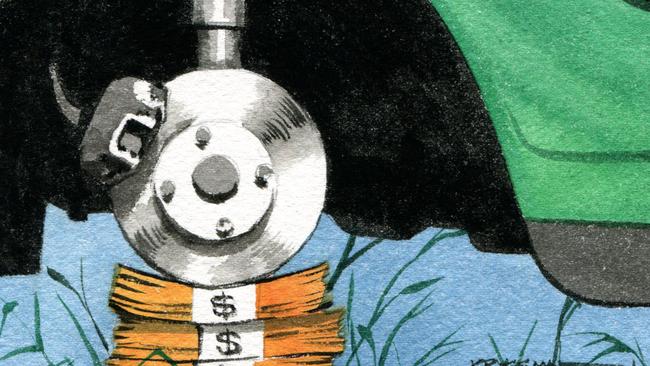
IN so far as the $500 million Green Car Innovation Fund was supposed to prevent carbon dioxide leaching from Australian-made cars, it looks like being an outstanding success.
Vehicles manufactured in Australia after 2018 will produce zero emissions, not least because Australia will be producing zero cars.
We did get the green cars, however. Well, greenish ones anyway, produced by Ford, Holden and Toyota with taxpayer subsidies.
About $14m was given to Ford to produce the Falcon Ecoboost, which retails for about $35,000, thanks to an $8000 contribution from the taxpayer.
According to motoring writers it’s a pretty good Falcon, almost as powerful as a real one.
“Brilliant!” Bill McKinnon wrote on the Top Gear website. “But also irrational and, in the end, irrelevant.
“The four-cylinder Falcon. Why is this car here? Now? Has anyone been screaming for it?”
The Ecoboost Falcon may produce enough torque to tow a semi-trailer of live pigs across the Nullarbor, but it is not what the market wants. A Falcon for tree-huggers is a contradiction in terms.
Joshua Dowling broke the bad news in News Corp Australia’s CarsGuide last week: “Confidential figures reveal just 1800 Ecoboost four-cylinder Falcons have been sold since it went on sale in April 2012 — less than half as many as Ford originally planned.”
Dowling uses the word “sold” loosely, since about 600 Ecoboosts were bought by Ford itself. So if you spot an Ecoboost on the road, there’s a one-in-three chance the driver is a Ford employee.
Will it help us reach our Kyoto target? Let us run through the maths.
Carbon emissions from full-strength Falcon: 226g/km. Carbon emissions from a Falcon Lite: 192g/km. Carbon saved: 34g/km. Carbon saved over 100,000km: 3.4 tonnes. Cost saving per tonne: $2300. Cost of a tonne of carbon abatement on the European market: $12.
It would be wrong to say there have been no winners. Holden Cruze purchasers, for example, scored a $1500 subsidy. Buyers of the Camry Hybrid have benefited to the tune of $1100.
The question, however, is why? When Kevin Rudd announced the green cars scheme in 2008 he claimed that “R&D, particularly those related to clean, green technologies, constitute a public good”. Yet the Ecoboost engine was already in existence. Ford’s Australian engineers merely turned it 90 degrees to run a rear-wheel drivetrain. Paradigm changing it was not.
When government takes a risk the private sector is unwilling to shoulder, the justification boils down to this: that society will better off for having a good thing.
Yet the private sector is cautious for good reason. Rushed technology driven by government funding comes at a high cost and is innately inefficient. The postwar aircraft industry is a shining example. If congress had been willing to pay half the cost of developing the jet airliner in the US, as the Labour government did in Britain, the US could have been the first to introduce jet travel.
As it was, Britain nobly led the way in 1952 with de Havilland Comet. Three of them broke up in mid-air within a year of entering service. As Richard R. Nelson pondered dryly in The Moon and the Ghetto, “How much would it have aided the reputation of the American commercial aircraft industry had it, and not the British, been the one to discover the catastrophic effects on pressurised aircraft of metal fatigue?”
Private risk is an effective regulator against ineffective and inefficient investment. Once R&D becomes an autonomous activity, separated from the pressures of the market, it runs rampant. It creates its own class of rent-seeker, driven by a thirst for subsidies rather than honest profit.
This, scarily, may be the condition of the windmill industry, a power source of questionable reliability and enormous cost that no private investor would look twice at were it not for boondoggles like the renewable energy target. Perhaps the technocrats are right; perhaps in time the industry will make technological leaps that will wean it off subsidies.
History suggests otherwise. The notion that government investment in technology will turn Australia into a clever country and generate the jobs of the future has been proven wrong repeatedly.
Now that all three remaining car manufacturers have announced plans to pull out of Australia, the green car fiasco looks like an expensive mistake.
Yet at the time plenty of people were prepared to egg Rudd on. Labor’s John Brumby, then Victorian premier, declared: “This is a green-letter day. It is a fantastic day for the auto industry.”
Kim Carr, the innovation, industry, science and research minister, boasted “the primary objective here is to ensure we have high skilled, high-wage jobs for Australian workers”.
The ABC’s Rachel Carbonell editorialised: “The hybrid car deal is a starting point for a greater range of local green transport in Australia.”
The Productivity Commission begged to disagree, warning: “It is unlikely that overall sales of green vehicles would increase markedly … policies that target use of particular abatement technologies become redundant, and will only impose additional, unnecessary costs.”
Australian Manufacturing Workers Union spokesman Ian Jones responded: “We have grown to expect this sort of rubbish from them, they have historically been anti-manufacturing industry.”
Six years later, with the folly of auto welfare laid bare and the budget deficit mounting, the Green Car Innovation Fund’s critics have been vindicated, and the naked self-interest of the unions, car manufacturers and Labor governments in Victoria and South Australia are plain for all to see.
It may not have been Labor’s most expensive folly but it is money that Joe Hockey would dearly love to get back. He could do so by re-indexing excise on petrol, making it a little more expensive at the pump, but Labor and the Greens — the green motoring champions — are determined to block that.


